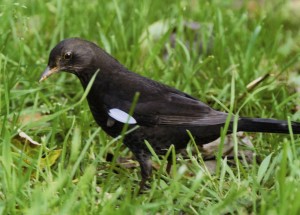 The numbers of unusual looking birds in gardens seems to have increased in recent years. This has been highlighted by a recent survey that has come up with a very wide range of birds involved. Over 1,500 birds have been recorded with an amazing 35 different species. Robins, blue tits, chaffinches, blackbirds and jackdaws have been included in the long list. However, there may be a simple answer to this in that it is not the numbers and range of birds that have increased quite remarkably. It could be, quite simply, the very large upsurge in interest by people in garden birds. There must now be far more people now than there have ever been looking at birds in the garden. This is mainly because of the latest “pastime” of feeding birds in gardens and providing shelter in the form of shrubs and nestboxes. This is now a multimillion pound, and growing, industry and this is reflected by the sheer numbers of people taking an interest in what many refer to as “their garden birds”. You only have to look at any of the Garden Centres or even large shops let alone the pet shops to realise just how widespread this has become. For some it is an occasional look at birds through the window whilst for others there is the daily notes to be taken of the actual numbers and type of food being taken.
The numbers of unusual looking birds in gardens seems to have increased in recent years. This has been highlighted by a recent survey that has come up with a very wide range of birds involved. Over 1,500 birds have been recorded with an amazing 35 different species. Robins, blue tits, chaffinches, blackbirds and jackdaws have been included in the long list. However, there may be a simple answer to this in that it is not the numbers and range of birds that have increased quite remarkably. It could be, quite simply, the very large upsurge in interest by people in garden birds. There must now be far more people now than there have ever been looking at birds in the garden. This is mainly because of the latest “pastime” of feeding birds in gardens and providing shelter in the form of shrubs and nestboxes. This is now a multimillion pound, and growing, industry and this is reflected by the sheer numbers of people taking an interest in what many refer to as “their garden birds”. You only have to look at any of the Garden Centres or even large shops let alone the pet shops to realise just how widespread this has become. For some it is an occasional look at birds through the window whilst for others there is the daily notes to be taken of the actual numbers and type of food being taken.
There are often queries about these unusual looking birds and these days identification has also been helped by the fact that photographs can now so easily be sent by email In the past this has varied from a strange coloured starling that looked like a nutcracker to a robin with lots of white feathers and even a goldfinch with an orange head rather than the usual red one. Some are easily noticed although one I had in the garden a few years ago was a different matter. It was a siskin that had just lost all its dark feathers so that it looked as though it had a green/brown plumage all over. It still almost went un-noticed. White feathers seem to be a very common variation and you can sometimes see a crow fly up with a few white feathers in its wings and, just occasionally, you get birds that are virtually all white. Sometimes a bird, such as the blackbird in the photograph, will only have a small patch of white feathers. However, birds that are white all over may not be albinos as true albinos with pink eyes are very rare. Perhaps one of the strangest ones was a pinkish coloured house sparrow that had had its feathers affected by eating food containing a pink dye at a fish farm. One clue in this case was that a small number of sparrows seemed to have be effected by the dye.
There was an interesting one in my garden last summer when a female mallard emerged one day with day old ducklings. The majority of the ducklings were the normal combination of brown and dark brown but one of them had a distinct pale yellow plumage. They came up from the pond and were soon feeding under the bird table. The pale yellow duckling looked so conspicuous I thought it would never get away with evading any of the predators such as crows. After a week or more it started to change to a darker brown and I thought it would revert back to the norm. But no, a close view last week showed it is now fully grown and still predominantly white.
